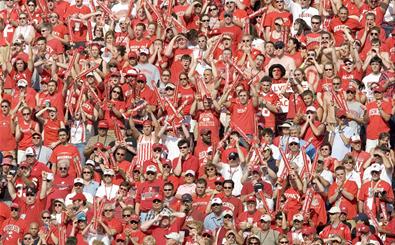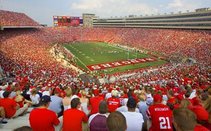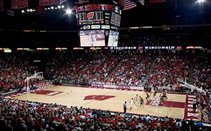In the Red Zone, et al
Today marks the first day of spring 2007 classes at the University of Wisconsin - Madison. Being students ourselves -- albeit ones nearing the ends of their collegiate careers -- the current 6 posters (there should be one or two more joining eventually) will still be attempting to maintain daily updates to this blog, but we're not perfect, and various things compete for our attention while we attend this wonderful institution. Jobs, student papers, Greek life, being social, and maybe even a little homework compete for our time, and obviously a blog such as this one may not be first or even 5th on such a priority list. Still, I am confident we Badger Backers can deliver, and who knows, we may even get more organized.
For the time being, I am VERY pleased with how things are going on this blog. Still, we need more content on a daily basis, and I for one hope to make sure that happens. To that end, last week I found myself with nothing to do late one night (it is winter break from classes, after all), and saw a mysterious copy of In the Red  Zone: The History of Camp Randall sitting on our shithole of an apartment's coffee table. Intrigued and in a somewhat sober state of mind, I walked into my room and popped it in my computer. I was expecting a crusty, boring historical review of Camp Randall stadium, from its roots as a Civil War training ground and Confederate POW camp to its now modern status as one of the top 25 places to play and watch collegiate football. What I got was far from crusty, and actually kind of interesting. While I knew most of the historical significance of Camp Randall's location, I didn't know details. Indeed, in this documentary, it was the details that were most interesting. For instance, I was unaware the Camp Randall site was a county and state fairground for years, serving as the site for the Wisconsin state fair until well into th
Zone: The History of Camp Randall sitting on our shithole of an apartment's coffee table. Intrigued and in a somewhat sober state of mind, I walked into my room and popped it in my computer. I was expecting a crusty, boring historical review of Camp Randall stadium, from its roots as a Civil War training ground and Confederate POW camp to its now modern status as one of the top 25 places to play and watch collegiate football. What I got was far from crusty, and actually kind of interesting. While I knew most of the historical significance of Camp Randall's location, I didn't know details. Indeed, in this documentary, it was the details that were most interesting. For instance, I was unaware the Camp Randall site was a county and state fairground for years, serving as the site for the Wisconsin state fair until well into th e 1900s before it moved to the Milwaukee area. I also didn't know the initial stadium was located around where the Engineering Hall and the Engineering sprinkler is located right now, rather than in the opposite southwest corner of the reserved land area. I also didn't know of the bleacher collapse in the old stadium, or the mysterious (to this day it remains unsolved) fire/arson of the old state fair grandstand in 1922. Plus, Camp Randall was used as a training ground and troop deployment area during World War I and II, as I remember. And did you know that in 1957, rather than add costly seating to top of the existing first tier, the university lowered the entire field more than 10 feet and added seats to the bottom of existing areas? It was around 1957 that UW football was hitting the big time, as well, with Alan "The Horse" Ameche winning the Heisman just 3 years before and a 3rd Rose Bowl appearance coming up against USC in 1963. I also knew stories about the dorm rooms in the east side of the stadium -- the so-called "rooms on the 50." I can imagine what a terrible living environment that had to be, but I think it would be totally worth it just for the story to tell your kids later in life. "Hey kids, do you know where I was when Alan Ameche ran in his Heisman winning season? I was sleeping underneath the 50 yard line!" In 1965 the upper deck was added, and in 2002 work began on the now completed renovations to C
e 1900s before it moved to the Milwaukee area. I also didn't know the initial stadium was located around where the Engineering Hall and the Engineering sprinkler is located right now, rather than in the opposite southwest corner of the reserved land area. I also didn't know of the bleacher collapse in the old stadium, or the mysterious (to this day it remains unsolved) fire/arson of the old state fair grandstand in 1922. Plus, Camp Randall was used as a training ground and troop deployment area during World War I and II, as I remember. And did you know that in 1957, rather than add costly seating to top of the existing first tier, the university lowered the entire field more than 10 feet and added seats to the bottom of existing areas? It was around 1957 that UW football was hitting the big time, as well, with Alan "The Horse" Ameche winning the Heisman just 3 years before and a 3rd Rose Bowl appearance coming up against USC in 1963. I also knew stories about the dorm rooms in the east side of the stadium -- the so-called "rooms on the 50." I can imagine what a terrible living environment that had to be, but I think it would be totally worth it just for the story to tell your kids later in life. "Hey kids, do you know where I was when Alan Ameche ran in his Heisman winning season? I was sleeping underneath the 50 yard line!" In 1965 the upper deck was added, and in 2002 work began on the now completed renovations to C amp Randall -- including Kellner Hall, two levels of suites, Bucky's Locker Room, and more bathrooms. And while I knew bits and pieces regarding "The Surge" in 1993, I didn't realize how dangerous and crazy it was. I'm amazed no one was killed. And I'm even more amazed it hasn't happened again, especially during a game like Michigan last season or Ohio State in 2004. Having sat in the student section for 4 years now, I don't think the danger of something like that has lessened at all, unless steps were taken that I am unaware of. The student section just often times gets too crazy for its own good (only occasionally), and I can't tell you the number of times I've been pushed into the people in front, behind, or to the side of me during a touchdown, interception, big play, etc. I just hope something like that doesn't happen again because of poor planning or refusing to learn from the past on our part.
amp Randall -- including Kellner Hall, two levels of suites, Bucky's Locker Room, and more bathrooms. And while I knew bits and pieces regarding "The Surge" in 1993, I didn't realize how dangerous and crazy it was. I'm amazed no one was killed. And I'm even more amazed it hasn't happened again, especially during a game like Michigan last season or Ohio State in 2004. Having sat in the student section for 4 years now, I don't think the danger of something like that has lessened at all, unless steps were taken that I am unaware of. The student section just often times gets too crazy for its own good (only occasionally), and I can't tell you the number of times I've been pushed into the people in front, behind, or to the side of me during a touchdown, interception, big play, etc. I just hope something like that doesn't happen again because of poor planning or refusing to learn from the past on our part.
Still, Its cool to think about the historical significance of the building I'm sitting in right now, the ground beneath my feet, and the countless Wisconsin athletes who helped to make the football program, the athletic department, and the university itself what it is today. I'm glad I watched the video for that reason alone, but also because it makes me appreciate the facility that much more, and not j ust take it for granted even when I've spent so much time here. I may not have been around to see "Crazy Legs," "The Horse," or even one of my personal favorites, Rufus Ferguson and his patented "shuffle," but thanks to DVDs like this, I can at least experience them in some capacity. And even if Rufus' shuffle pales in comparison to "The Icky Shuffle" used by Bengals running back Icky Woods in the early 1990s -- immortalized through Tecmo Super Bowl fame, you still gotta love the fact that Wisconsin had a tailbac
ust take it for granted even when I've spent so much time here. I may not have been around to see "Crazy Legs," "The Horse," or even one of my personal favorites, Rufus Ferguson and his patented "shuffle," but thanks to DVDs like this, I can at least experience them in some capacity. And even if Rufus' shuffle pales in comparison to "The Icky Shuffle" used by Bengals running back Icky Woods in the early 1990s -- immortalized through Tecmo Super Bowl fame, you still gotta love the fact that Wisconsin had a tailbac k that was that charismatic. Can you imagine Ron Dayne ever doing something like that? Not Brian Calhoun, he's too much of a class act. Anthony Davis probably would've gotten hurt halfway through his form of the shuffle, which probably would've been hyped up to be the greatest thing in the world, been awesome for the first few seconds, then collapsed into a fit of wussy whining and inability to do it in big games or after big touchdowns. Wait, are we still talking about dancing? Hmm...maybe not. What I do know is that I would pay upwards of $100 for PJ Hill to start a new modern-day shuffle. Except I hope his shuffle involves some form of the new crazes to hit dance floors, like "picking up loose change," "my head hurts and my hand is on fire," and "the paint machine." Seriously PJ, make this happen, we beg of you. I mean, someone has to bring that sexy back. YEAH!
k that was that charismatic. Can you imagine Ron Dayne ever doing something like that? Not Brian Calhoun, he's too much of a class act. Anthony Davis probably would've gotten hurt halfway through his form of the shuffle, which probably would've been hyped up to be the greatest thing in the world, been awesome for the first few seconds, then collapsed into a fit of wussy whining and inability to do it in big games or after big touchdowns. Wait, are we still talking about dancing? Hmm...maybe not. What I do know is that I would pay upwards of $100 for PJ Hill to start a new modern-day shuffle. Except I hope his shuffle involves some form of the new crazes to hit dance floors, like "picking up loose change," "my head hurts and my hand is on fire," and "the paint machine." Seriously PJ, make this happen, we beg of you. I mean, someone has to bring that sexy back. YEAH!





No comments:
Post a Comment